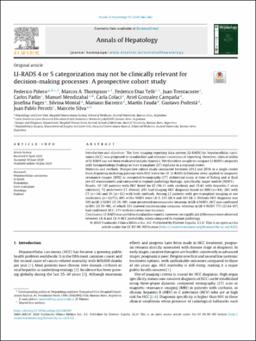LI-RADS 4 or 5 categorization may not be clinically relevant for decision-making processes: A prospective cohort study

View/
Date
2020-11Author
Piñero, Federico.
Thompson, Marcos.
Diaz Telli, Federico.
Et al.
Metadata
Show full item recordAbstract
Abstract
Introduction and objectives: The liver imaging reporting data system (LI-RADS) for hepatocellular carcinoma (HCC) was proposed to standardize and enhance consensus of reporting. However, clinical utility of LI-RADS has not been evaluated in Latin America. We therefore sought to compare LI-RADS categories with histopathology findings in liver transplant (LT) explants in a regional center.
Materials and methods: Prospective cohort study conducted between 2012 and 2018 in a single center from Argentina including patients with HCC listed for LT. LI-RADS definitions were applied to magnetic resonance images (MRI) or computed tomography (CT) abdominal scans at time of listing and at final pre-LT reassessment and compared to explant pathology findings; specifically, major nodule (NOD1).
Results: Of 130 patients with HCC listed for LT (96.1% with cirrhosis and 35.6% with hepatitis C virus infection), 72 underwent LT. Overall, 65% had imaging HCC diagnosis based on MRI (n = 84), 26% with CT (n = 34) and 9% (n = 12) with both methods. Among LT patients with pre-transplant imaging at our institution (n = 42/72), 69% of the NOD1 were LR-5, 21% LR-4 and 10% LR-3. Definite HCC diagnosis was 50% in LR-3 NOD1 (CI 18-90); none presented microvascular invasion. In LR-4 NOD1, HCC was confirmed in 89% (CI 59-98), of which 11% showed microvascular invasion; whereas in LR-5 NOD1 77% (CI 64-87) had confirmed HCC, 17% with microvascular invasion.
Conclusions: LI-RADS was useful to standardize reports; however, no significant differences were observed between LR-4 and LR-5 HCC probability when compared to explant pathology.
Keywords: Explant; Hepatocellular carcinoma; Histology; LI-RADS; Liver transplant; Probability.
Copyright © 2020 Fundación Clínica Médica Sur, A.C. Published by Elsevier España, S.L.U. All rights reserved.
PubMed Disclaimer
Collections
The following license files are associated with this item:

